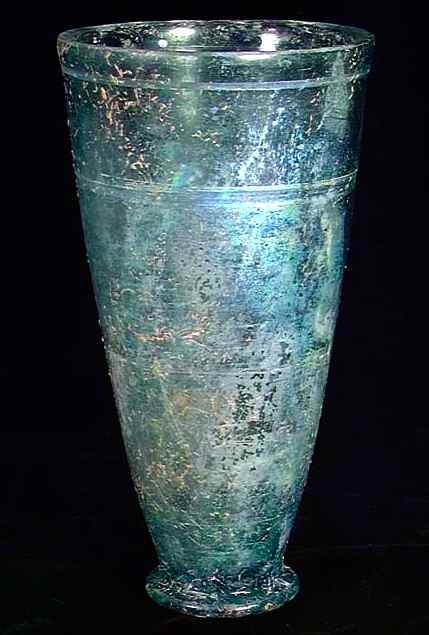

Title: Rare Ancient Roman Iridescent Glass Beaker 1st century AD
Shipping: $69.00
Artist: N/A
Period: Antiquity
History: N/A
Origin: N/A
Condition: Museum Quality
Item Date: 1st-2nd century AD
Item ID: 5214
FINE LATE ROMAN OR FRANKISH WHEEL-CUT GLASS BEAKER, ca. 1st-2nd century AD. The pale aqua blue glass vessel tapering gracefully up from a slightly widened base, three wheel-cut bands around, the glass thicker and more substantial than in many examples. 3.25 x 6 inches. Areas of pale iridescent deposits and traces of dendrites. Some stable lines in the glass but its thickness gives it strength. Cf. Habib Anavian Collection, #89 for a nearly identical though smaller example, also with engraved measurement lines, from Syria. Provenance: Ex Christie's with Christie's tag still attached. This is a featured art consignment piece. All collectibles are curated distinguishable art objects from top end collections. We’ve built an exceptionally sophisticated safe infrastructure with a proven consignment management system featuring high quality visual art and antiques, for both buyers and sellers. All published works of art must be unique & rare in order to receive an invitation to join our exclusive gallery forum. You can reach us if you have any questions. 415-776-0104
Link: http://en.wikipedia.org/wiki/Ancient_glass_trade
The ways in which glass was exchanged throughout ancient times is intimately related to its production and is a stepping stone to learning about the economies and interactions of ancient societies. Because of its nature it can be shaped into a variety of forms and as such is found in different archaeological contexts (window panes, jewellery, tableware...). This is important because it can inform on how different industries of sections of societies related to each other - both within a cultural region or with foreign societies.
From Hellenistic times glass production sees considerable technological developments culminating with the introduction of glass blowing in the 1st century BC. Glass objects could now be made in large scale production, with less raw material and faster and as a consequence became more common. From the early Roman times, to Byzantine and early Islamic periods the glass from Northern Europe to Eastern Mediterranean shows an incredible compositional homogeneity in its major elements. Unlike the LBA glass, Roman glass was made from the melting of sand and natron - mineral soda - from the Wadi Natron in Egypt. With one raw material being common to all glass it should be possible to differentiate between glass made from different sands using composition variation of the trace elements and certain isotope ratios. These compositional analyses aimed to investigate two models for glass production: glass was produced in large scale primary workshops along the Levantine coast and Egypt, mixing natron and sand from the mouth of the Belus river - as mentioned by Pliny - and then traded to local glass working workshops. If natron was traded and mixed with local sands following a strict recipe could result in the homogeneous composition.
Glass making furnaces have been uncovered in Israel at two sites - 17 at Bet Eli’ezer and 3 at Apolonia. These are rectangular in shape measuring about 2m x 4m and matching in size a glass slab found inside a cave at Bet She’arim. The resulting slabs would be broken up into chunks that were traded to glass workshops in the Middle East and across the Mediterranean as evidenced by the contemporaneous shipwrecks carrying such glass chunks
By the 9th century the raw materials for glass shift again to quartz pebbles and plant ash and the ‘forest glass’ of medieval Europe.
Glass shows up in Northern India at the end of the 2nd millennium BC becoming more common throughout South East Asia during the following millennium. Glass beads in particular become extremely popular and together with bangles form the largest group of glass finds. From its Indian origins, glass beads spread to an area from Africa to Japan, sailing with the monsoon winds and leading to their christening as ‘Trade wind beads’. The most common compositional type, representing 40% of the glass finds for the region, is known as mineral soda-alumina glass and is found from the 4th century BC to the 16th century AD.